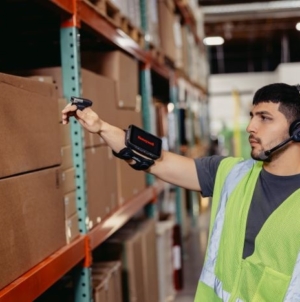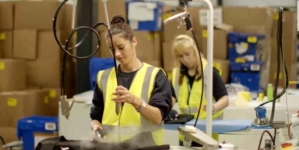-
BLACKOUT TECHNOLOGIES TARGETS TELEMATICS-INTEGRATED MOBILE DEVICE BLOCKING TO COMBAT SMARTPHONE DISTRACTION - April 1, 2025
-
OpenADR Alliance announces first OpenADR 3.0 certified products with EVoke Systems, E.ON Energy and Universal Devices - March 25, 2025
-
Growing fulfilment and contract packer appoints new Managing Director - March 25, 2025
-
When is it time to invest in a WMS? Understanding the key trigger points - March 25, 2025
-
eCapital helps Vantage Recruitment on its journey to financial success - March 24, 2025
-
Hugo Beck Celebrates 70 Years of Packaging Innovation with Open House Events - March 20, 2025
-
PROLOG FULFILMENT SUPPORTS LUNA DAILY’S COMMITMENT TO BETTER BODY CARE FOR ALL WOMEN - March 19, 2025
-
Motion Ventures launches largest-ever maritime tech fund at $100M to meet the industry’s new pace of adoption - March 18, 2025
-
ITD GLOBAL APPOINTS GROUP CHIEF REVENUE OFFICER - March 17, 2025
-
SURECAM TEAMS UP WITH ENTERPRISE FLEX-E-RENT FOR VEHICLE REPAIR & MAINTENANCE CONFERENCE - March 14, 2025
Why now is the time for retailers to get a handle on Returns Management.
When a £25 pair of jeans costs £14 to ship and return as well as the process of getting items back into inventory potentially taking up to ten weeks*, clearly retailers have got a problem. And yet “free returns” and options such as buy online, return in store, are now expected by customers. With 44% of customers ordering with a view of returning at least part of the order, and 58% less likely to use a retailer if returning items is a challenging process**, Gareth Thomas, Retail Business Consultant at Zetes, insists effective returns management has become a critical component of the retail business model. Addressing this challenge needs to be placed higher up the business agenda so that retailers can have returned items back selling on shelves quickly, in the optimal location whilst simultaneously reducing the cost of the returns process.
When stock and money are tied up
How much longer can retailers afford to consider free returns to be a loss leader? Especially when just a handful can accurately measure the true cost of managing returns throughout the business. While there is strong evidence that the option to buy online and return in-store is driving customer footfall and prompting additional spend, few retailers are effectively managing that returns process to accurately analyse the complete cost of sale.
The problem is that, traditionally, the amount of in-store returns has been relatively small. Now, in an omnichannel model offering buy anywhere, return anywhere, in-store returns are growing exponentially and the implications for operational profit are significant. It is estimated that returns cost UK retailers £70 billion every year*; with some retailers confirming as much as 10% of inventory is unavailable for sale at any one time as it passes through the returns process – this is a lot of working capital tied up in stock not available for sale.
Just because a product is scanned through the POS when returned by a customer does not ensure it is back on sale. How long does that item spend in a basket behind the counter or in the stock room before it is placed back on the shelf? What about products that are not stocked in that store – how long will it take to get them back to the distribution centre? How much will it cost – is it really worth it, or would it make more sense to mark the item down and place it on the sale rail in store?
Gaining greater visibility
It is a given that without an automated inventory system, updated in real-time to provide a single view across the entire organisation, a retailer cannot begin to improve its returns management process. But that is just the start; this real-time view needs to be combined with intelligent processes that capture data regarding the returned item and ensures that staff are equipped to manage and reallocate it correctly to maximise stock availability, whilst minimising cost.
For example, if an item is not stocked in the store it is returned to, the system should automatically guide the Store Associate to either mark it down and place on the sale rail or pack it up for return to the Distribution Centre (DC); a decision that will reflect not only the product’s value if it was originally sold at full price or the reverse logistics costs of getting it back to the DC but also evolving factors such as the overall consumer demand levels for the item. All return items should be automatically rerouted and quickly put back into inventory in the relevant sales channel rather than not being available for resale.
Additionally, a retailer’s system should also improve insight into the entire returns process to inform not only the way returned products are handled but also on-going strategy. An example would be, if a particular product line is suffering from a higher level of returns over others, this insight should feed into future buying decisions, or even prompt a product recall if there are quality issues.
All systems should have the capability to leverage an existing POS system and retailers need to remember that revolutionising the returns process doesn’t involve a complete systems overhaul.
Turning returns into resalable items
A generous returns policy may be essential to secure the order but that process has to be effective; the quality of the returns process has a direct impact on a customer’s decision to continue with a brand.
And if retailers are to avoid fundamentally compromising profitability, the returns process needs an overhaul as the number of customers with a view to return at least part of the order can only increase, adding ever more cost to the retailer. While the argument that products returned in-store can generate incremental sales can be made, clearly that figure needs to be understood in the context of the entire cost of return, not just the individual item value.
Returns management has become an essential component of the retail offer; to retain both profitability and customer experience, it is essential to put the systems in place to maximise the value of the return – from reselling it in-store to getting it back into the supply chain via robust reverse logistics processes. With sales in full swing and further annual peak periods fast approaching, retailers who recognise the need to better managing their returns process now will be those who reap the rewards year on year for both them and their customers; whilst the competition remains in panic mode.
Gareth Thomas, Retail Business Consultant, Zetes
*The British Retail Consortium’s Retail 2020 Report, May 2017
**Zetes’ Understanding the role of the store in omni-channel retailing’ report, May 2017

































